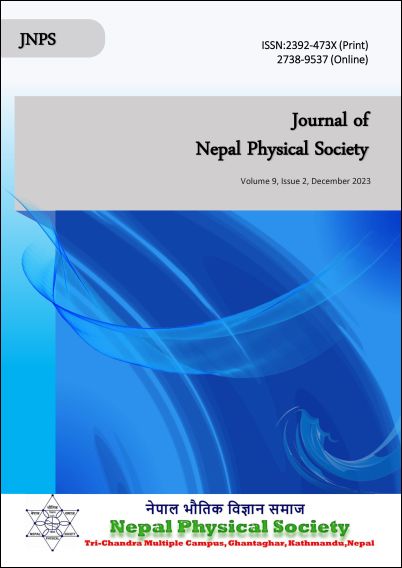Anion Exchange Membrane Functionalized by Phenol-formaldehyde Resins: Ion Exchange Capacity, Electrical Properties, Chemical Stability, Permeability, and All-iron Flow Battery
DOI:
https://doi.org/10.3126/jnphyssoc.v9i2.62322Keywords:
Ion exchange capacity, Electrical properties, Chemical stability, Permeability, All iron flow batteryAbstract
An anion exchange membrane (AEM) is a type of selectively permeable membrane that facilitates the movement of negatively charged ions while impeding the passage of positively charged ions. These membranes are designed to selectively transport anions across them based on their charge and size. They are commonly used in various electrochemical devices and processes, such as fuel cells, electrodialysis, electrolysis, water treatment, and other applications requiring ion exchange. These membranes are typically made from synthetic polymer materials with positively charged functional groups that attract and transport anions while repelling cations. They are used for selection, conduction, and stabilizing the ion anion exchange phenomena. We recently released a study on the creation of a quick and easy approach to creating an AEM with increased ionic conduction capacity and good alkaline stability. The technique's simplicity makes it a desirable substitute for conventional methods. By using this approach, the carcinogenic reagent often employed for AEM preparation—chloromethyl methyl ether—is avoided. Membrane surfaces appeared to be rather homogeneous in Scanning Electron Microscope (SEM) pictures. Water content, ion exchange capacity, and electrical conductivity all improved as the amount of ion-exchange material in the casting fluid increased. The Thermogravimetric Analysis (TGA) of the membranes revealed thermal stability up to 150°C which shows that these membranes are ideal for applications in that temperature range. The composite membranes exhibited enhanced chemical stability in strong chemical environments and this can be attributed to the resonance stabilized guanidine group as negative ion-exchange site. By considering the AC impedance data, the conductivity measurements showed a marked enhancement in conductivity by increasing the content of ion-exchange material. Galvanostatic charged discharge tests were used to examine the electrochemical performance of an all-iron redox flow cell, and the system demonstrated a columbic efficiency of 80% during the repeated charge-discharge cycles. The findings of this work provide a compelling alternative to the established methods for the synthesis of AEMs.
Downloads
Downloads
Published
How to Cite
Issue
Section
License
All right reserved. No part of this Journal may be reproduced in any form or by any electronic or mechanical means, including information storage and retrieval system, without permission in writing from the publisher, except by a reviewer who may quote brief passage in a review. The views and interpretation in this journal are those of author(s) and they are not attributable to the NPS.




